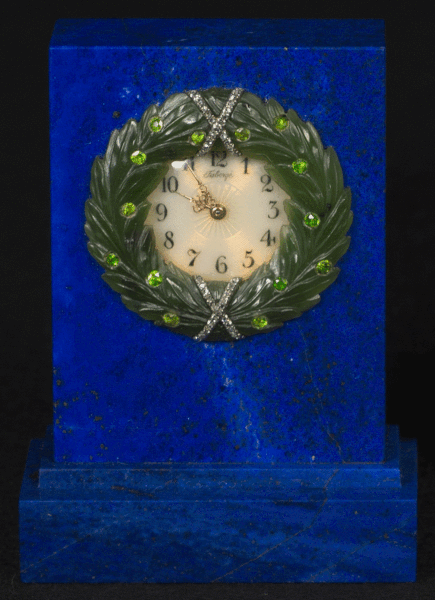This small Fabergé watch-clock dates to the late 19th century. The clock’s interior and complication
This small Fabergé watch-clock dates to the late 19th century. The clock’s interior and complications are made of metal, mostly brass, but the exterior is made of a variety of precious and semi-precious stones including carved jade, emeralds, and diamonds. The stone comprising the majority of the clock’s case had been previously identified as lapis lazuli based on its vivid and deep blue color, as well as because of the presence of gold-colored pyrite flecks. Also known as “Fool’s gold,” pyrite is a common and desirable inclusion in lapis lazuli. Calcite, a white calcium carbonate mineral, is also commonly associated with lapis lazuli. With historic sources in both Afghanistan and the Andes, lapis lazuli has been valued for decorative stonework since antiquity. Lapis lazuli can also be processed to create the blue pigment ultramarine.When the watch-clock arrived in the Conservation lab, conservators used a digital imaging technique called multiband imaging (MBI) to learn more about the lapis lazuli. Like indigo, lapis lazuli stone and ultramarine pigment appear bright in a type of composite image referred to as infrared subtraction. An infrared subtraction image is generated by taking the difference of infrared images captured using two different band pass filters, one at 735nm and one at 660nm. Areas appearing blue in visible light and bright in the infrared subtraction image are most likely lazurite, the mineral giving lapis lazuli and ultramarine their blue color. The calcite matrix and pyrite inclusions in lapis lazuli are dark in the subtraction image, as are the watch-clock’s metal, glass, jade, and diamond components.The watch-clock with visible light (left), infrared subtraction (center), and false color infrared (right).Also similar to indigo, lapis lazuli appears red in false color infrared images, another type of composite image created by combining a visible light image with an infrared image captured using an 830nm cutoff filter. Interestingly, the green gemstones, likely emeralds, are bright in the infrared subtraction image but pink in the false color infrared image. Captured using different filters, the infrared images themselves can also help characterize a material. In these images, the lapis lazuli appears brighter with the 830nm cutoff filter and darker with the 660nm bandpass filter, giving information about which wavelengths the stone reflects and which it absorbs.Infrared images of the clock captured using the 830nm filter (left), the 735nm filter (center), and the 660nm filter (right).The watch-clock will be on view beginning in May as part of the upcoming iteration of Infinite Blue.Posted by Victoria Schussler -- source link
Tumblr Blog : brooklynmuseum.tumblr.com
#bkmconservation#faberge#watch#clock#bkmdecarts#metal#brass#precious#stones#jade#emeralds#diamonds#lapis lazuli#blue#color#gold#pyrite#calcite#mineral#afghanistan#andes#stonework#decorative#decorative arts#ultramarine#multiband imaging#mbi#art conservation#conservation#conserators
